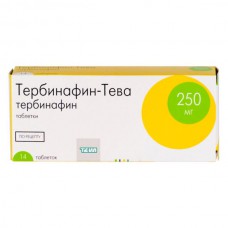Expiration date: 02/2026
Clinico-pharmacological group
- Antifungal agent
- Antifungal drug for topical use
Pharmachologic effect
Antifungal allylamines group. It has action by inhibiting squalene epoxidase in the fungal cell membrane. This leads to a deficiency of ergosterol and to an intracellular accumulation of squalene, which causes the death of the pathogen cells.
It has fungicidal effect on dermatophytes, molds and certain dimorphic fungi, yeast and yeast-like fungi. On some types of yeasts can act fungistatic.
It is active against pathogens tinea (Trichophyton / including Trichophyton rubrum, Trichophyton mentagrophytes, Trichophyton tonsurans, Trichophyton verrucosum, Trichophyton violaceum /, as Microsporum canis and Epidermophyton floccosum), yeast of the genus Candida fungi (mainly Candida albicans), the causative agent of multi-colored zoster (Malassezia furfur).
Pharmacokinetics
After oral administration, it is well absorbed from the gastrointestinal tract. Binding to plasma proteins - 99%. Terbinafine diffuses through the dermal layer of the skin and accumulate in the lipophilic stratum corneum sebum secreted as a result of this are high concentrations in hair follicles, nails. During the first few weeks after the start of terbinafine accumulates in the skin and nail plates at concentrations providing fungicidal activity. It is metabolized in the liver to inactive metabolites. Excreted in the urine primarily as metabolites. T1 / 2 - 17 hours.
Dosage
Inside adults - 250 mg / day in 1 or 2 divided doses. The duration of treatment depends on the indication and the severity of the infection: in skin lesions - 2-4 weeks, with the defeat of nails - from 6 weeks.. up to 4 months or more. Children weighing more than 40 kg - 250 mg / day, 20-40 kg - 125 mg / day, up to 20 kg - 62.5 mg / day.
External used 1-2 times / day for 1-2 weeks.
Drug interactions
Drugs associated with the induction of hepatic microsomal enzymes, increase the clearance of terbinafine, drugs that inhibit hepatic microsomal enzymes - reduce clearance of terbinafine.
Pregnancy and lactation
Experience in the use of terbinafine in pregnancy is limited. If necessary, the appointment during lactation should decide the issue of termination of breastfeeding.
Side effects
From the digestive system: nausea, anorexia, mild abdominal pain, diarrhea, disorders or loss of taste, cholestasis, jaundice, hepatitis.
Allergic reactions: skin rash, rarely - arthralgia, myalgia, erythema multiforme, Stevens-Johnson syndrome.
CNS: headache.
Co Hematopoietic system: neutropenia, thrombocytopenia.
Local reactions: redness, itching, burning sensation.
Testimony
For oral administration: fungal infections of the skin caused by dermatophytes - trihofitia, athlete, mikrosporiya, fungal nail infections (onychomycosis), candidiasis.
For external use: fungal infections of the skin caused by dermatophytes, candidiasis, pityriasis versicolor.
Contraindications
Hypersensitivity to terbinafine.
Special instructions
It should be used with caution terbinafine oral in patients with impaired liver and / or kidney disease, as well as in the elderly.
Use in impaired renal function
It should be used with caution terbinafine oral in patients with impaired renal function.
Application for violations of liver function
It should be used with caution terbinafine oral in patients with impaired hepatic function.



